Understanding Factors That Keep Pet Birds Grounded
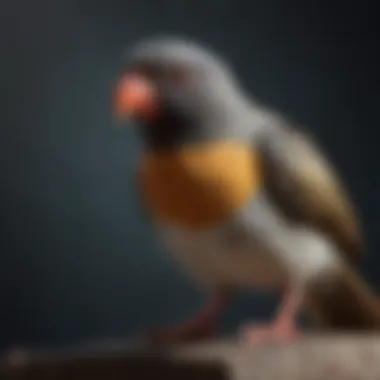
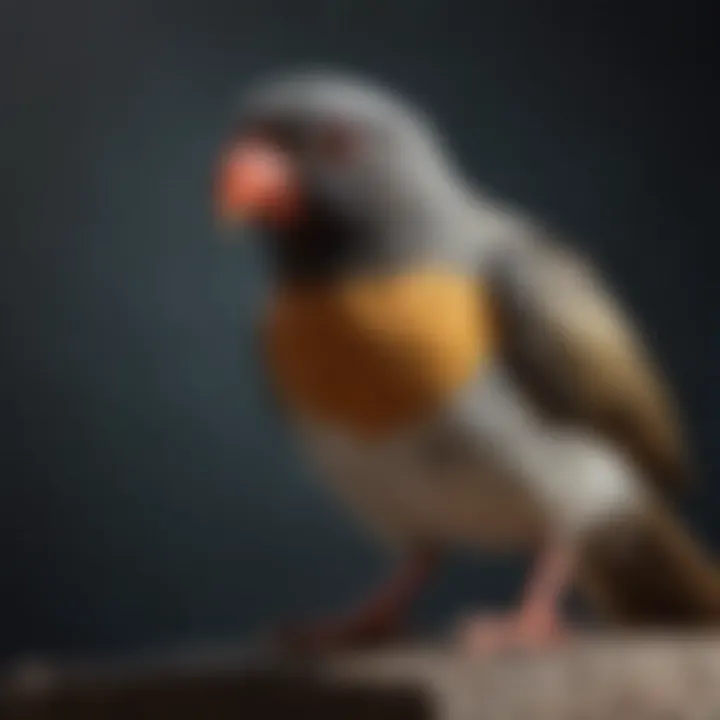
Intro
Understanding the dynamics of why pet birds remain grounded is vital for pet owners looking to enhance their relationship with their avian companions. Pet birds differ significantly from their wild counterparts due to factors like domestication, environment, and care practices. This article explores various reasons that inhibit flight in domestic birds, from their physical anatomy to their daily routines. In doing so, it provides bird enthusiasts with a deeper insight into their pets’ behaviors and well-being.
Care Tips
Daily Care Routines
Daily care in a bird's life shaped its health and behaviors. Establish a consistent feeding schedule, monitor food intake, and offer fresh water. Interaction is key; hands-on time helps bond and can reduce stress behaviors. Daily activities should include letting your pet explore outside its cage under supervision for slight exercise, vital even for ground-based birds.
Cage Setup and Maintenance
The cage significantly influences a pet bird's ability to fly or feel secure. A spacious cage promotes movement but should be designed to prevent escapes. Perches at varied heights allow birds to jump and climb. Keep the cage clean to avoid infections. Consider placing items that encourage foraging within reach; it promotes physical and mental activity.
Hygiene and Cleaning Practices
Good health starts with cleanliness. Adjust cleaning frequency based on bird size and species, but a weekly clean is advisable. Wipe down surfaces, wash feeding dishes and replace dirty bedding or litter. Regular hygiene practices contribute not only to a healthy environment but also affect your bird's behavior, as avian stress can lead to unwanted negative actions.
Seasonal Care Adjustments
With changing seasons, pets may need altered care. In warmer months, cool down cages to avoid heat stress. Conversely, in colder months, ensure that the environment is warm but not stuffed, avoiding drafts. Seasonal changes may also influence their diet and energy levels.
Behavioral Insights
Understanding Bird Body Language
Birds communicate through body language often. Observing your pet’s mood can help mitigate potential aggression or fear. For example, when wings are lifted or feathers puffed, it can indicate distress. Reading these signs creates a better experience for both bird and owner.
Common Behavioral Issues and Solutions
Pet birds may exhibit number of behaviors, including biting or feather plucking. Understanding triggers is critical. Aggressive behaviors might be associated with stress or fear, while any excessive grooming can indicate boredum or anxiety. Engage with your bird more through interactions and toys to alleviate these types of issues.
Positive Reinforcement Techniques
Training through positive reinforcement encourages good behavior. Treats can work well for teaching commands or tricks. When a pet bird performs a desired action, offer immediate rewards—turn its actions into learn-ng experiences without creating stress or pushing it unnecessarily.
Social Interaction Needs
Birds are social and thrive on interaction, whether with other birds or humans. Create a structured social routine; arranging playdates with other pet birds could idolize their social needs and promote healthy development mentally and emotionally.
Nutrition Guides
Essential Diet Components
To thrive, pet birds need nutrition that mirrors their wild diets. Fresh fruits, vegetables, seeds, and pellets should form the core parts of their diet. Quality pellets with added vitamins ensure balanced nutrition, preventing deficiency and promoting vibrant feathers and strong immune systems.
Safe and Toxic Foods
It’s essential to learn which foods are safe. Foods like apple and carrots can be beneficial, while items such as chocolate, caffeine, and avocado can be harmful. Study extensively and consult trusted resources before introducing new foods.
Supplements and Treats
Occasional supplements can aid in filling nutritional gaps. Many birds also enjoy treats to create enjoyable moments, but moderation is crucial. Treats should supplement regular meals, not replace them, as they can lead to obesity if offered in excess.
Feeding Strategies for Different Species
Different species have varied needs. Larger species like macaws may have a more significant nutritional demand compared to smaller birds like budgerigars. Research to determine specific species’ feed requirements to ensure health and vitality.
Wellness and Health
Routine Health Checkups
Regular vet visits help early detect potential health problems. Establish a relationship with a vet specialized in avian care and schedule biennial exams, considering a need for more frequency in older birds.
Identifying Symptoms of Illness
Practicing awareness of changes can prevent worsening health issues. Symptoms like lethargy, feather loss, or abnormal droppings might indicate more profound problems. Prompt consultation with a vet ensures that any emerging issues get attention.
Preventative Care and Vaccinations
Vaccinations should be part of your bird’s healthcare regime, protecting against prevalent diseases in avian species. Offsetting risks prevents some seasonal challenges when care threshold lowers, especially in social birds or those shared in environments with much movement.
Mental and Emotional Well-being
Birds require stimulation beyond practical care. Visual and auditory enrichment improves a pet’s emotional health. Engage them with rich interactions to make environments compelling and vibrant.
Enriching Activities
Toys and Playtime Ideas
Rotate toys to keep activities fresh, serving physical and cognitive development simultaneously. Safe, durable toys suit your choice; interactive options or foraging toys challenge and can entertain, so explore a selection periodically.
Training and Tricks
Birds learn kinesthetically. Teaching simple commands, or leveraging training sessions, keeps engagement high. Employ varied tricks to exercise both the mind and body, resulting in greater appeal and retention.
Outdoor Activities and Interaction
While fly time can be limited indoors, supervised outings outdoors under constraints of tethers or enclosures can offer broad ecological richness. Explore various areas throughout walks with avian-friendly practices.
DIY Projects for Mental Stimulation
Often, engaging positive outlets encourage brain activity. Implementing DIY projects from simple interacting with craft supplies for in-cage enrichment promotes organizational agency over behavior can offer much significance in nurturing since most birds are inevitable with the establishing strategies applied.
**“The well-being of your pet birds is contingent upon the synergy between their care, environment, and social interaction.
Anatomical Adaptations in Pet Birds
Anatomical adaptations play a critical role in understanding why pet birds often do not utilize their flying abilities. These adaptations encompass various physical characteristics that greatly influence flight mechanics as well as the behaviors exhibited by avian species in a domestic setting. Familiarizing oneself with these adaptations is vital for pet owners, as they can impact the overall health and well-being of these feathered companions. Therefore, examining anatomical features helps in creating optimal environments that respect their natural instincts and capabilities.
Wing Structure and Functionality
The anatomy of bird wings serves more than just aesthetics; it is a determinant of their ability to fly or remain grounded. Bird wings are composed of feathers, muscle, and bone, each contributing to the overall function. Specific muscular arrangements allow birds to generate significant lift while flapping. This lift creates an upward force that counteracts gravity.
Different species showcase distinct wing structures based on their habitat and lifestyle. For instance, pet birds such as cockatiels and parakeets have shorter and broader wings which provide greater maneuverability in constrained areas like a house. In contrast, larger species with elongated wings may excel in long-distance flight but may find themselves in a challenging environment if not provided the appropriate space. This discrepancy plays a major role in determining the bird's inclination to take flight, especially in a domestic environment.
Familiarizing oneself with wing anatomy can guide owners in health assessments as well. Routine inspection helps identify if a bird's wings have been properly maintained or if they are being clipped excessively, both of which impact flying behavior directly.
Weight Distribution and Its Impact
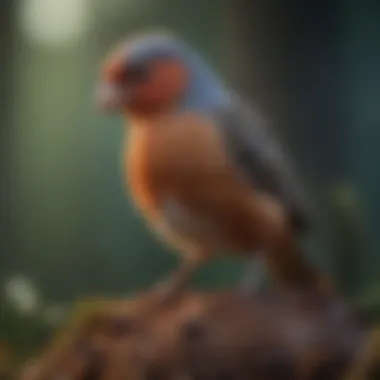
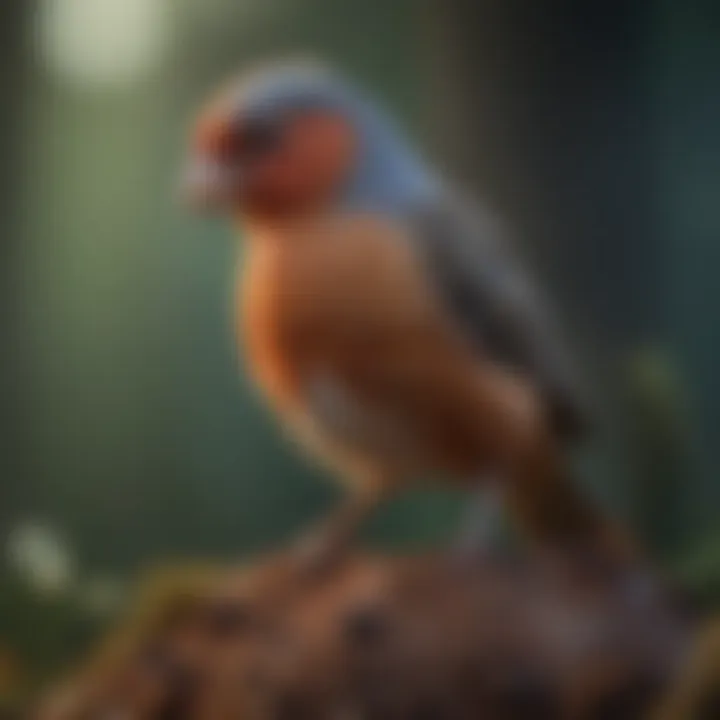
Weight distribution hails as another influential anatomical factor affecting flight ability. An imbalance due to obseity or improper habitats can severely restrict a bird's agility. Birds with excessive fat can struggle to lift off, making them prone to grounded behavior.
Understanding the importance of weight distribution allows for informed dietary choices. A balanced diet is crucial but also requires awareness of the physical activity needs of pet birds. Proper weight management assures pet birds remain agile, allowing them some facility with flight.
To promote healthy weight distribution, pet bird owners should engage birds in physical activities regularly. This helps avoid not just conditions related rainfall, but it also fosters better mental health through play and stimulation. Overall, encouraging physical movement and maintaining a helthy weight prevents unwarranted grounding.
Behavioral Characteristics of Domesticated Birds
Behavioral characteristics play a crucial role in understanding why pet birds often do not display the instincts to fly away. These behaviors are not merely remnants of their wild ancestry; instead, they are shaped by their circumstances, surroundings, and interactions. Bird owners must recognize these characteristics as a means of fostering a safe and nurturing home environment for their pets.
Instinctual Behaviors of Captive Birds
Captive birds exhibit specific instinctual behaviors that govern their daily lives. One of the most important is their innate sense of security. In the wild, birds fly to escape threats, but domesticated birds may view their home as a relatively safe space. This perspective is paramount in reducing their desire to explore beyond the confines of their cages.
In a familiar environment, behaviors like flapping and jumping may express their excitement, but these motions do not always equate to a strong urge to fly. Having activities and structures that allow them to simulate flight—such as perches of various heights—also influences their instinctual responses. Bird owners can enhance safety by integrating these elements into their pets’ living spaces. Not only does this provide enrichment, but it also satisfies their natural tendencies to explore their territory.
Instincts rarely operate in isolation. Factors such as age, species specificity, and even individual temperament contribute to how strongly these behaviors manifest in domestic birds. Young birds, for example, show more exploration tendencies as they learn about their world, while older birds may prefer the familiarity of their environment.
Attachment to Their Environment
Attachment to their surroundings is another critical behavioral aspect. Birds develop bonds with their habitat, making them less inclined to venture away. These bonds result from daily routines and interactions with their owners. Versatile environments, containing toys or safe areas for movement, exemplify how owners can establish strong emotional ties between birds and their homes.
The size and layout of the bird's cage also matter. A spacious environment offering areas for play and perching can foster a sentiment of belonging, which often diminishes the instinct to escape. Even the use of sounds, such as soft music or the chirping of nearby birds, can draw their focus and further soothe them.
Ultimately, sustaining this attachment requires consistent attention and care from owners. Through regular engagement, birds learn to associate their home with safety and satisfaction, positioning them in a state of relaxed confidence rather than anxious drivers of escape.
A bird that feels safe and enriched within its environment is less likely to take flight, grounded not just in body but in spirit too.
Environmental Factors That Influence Flight Behavior
Environmental factors play a critical role in a pet bird's inclination to fly. This is especially significant when exploring their grounded behavior. Owners must acknowledge that a bird’s environment can either empower or limit their capacity for flight. In evaluating these factors, we can uncover ways to create supportive surroundings, leading to happier and healthier pet birds.
Cage Size and Design
The size and design of a cage are fundamental aspects that directly influence a bird's behavior. A spacious cage allows for abundant movement, which is vital for any bird's overall well-being. Birds require room to spread their wings and flutter around, promoting natural flying habits. Conversely, a smaller cage can hinder their ability to exercise and encourage restlessness.
Moreover, the design of the cage can affect the behavior of pet birds in other ways. Transparent cages, such as glass or acrylic, may create a sense of entrapment. Birds naturally prefer cages that provide a safe retreat while still aiding their physical movement. By incorporating vertical space through multi-level designs, owners can successfully maximize flight opportunities. It’s also important to note that the incorporation of various openings can enable spontaneous flight, without necessarily compromising safety.
Key considerations for cage design include:
- Adequate space for free wing extension
- Safeguarding elements, like multiple exits
- Vertical elements to promote climbing and short glides
Adapting to any peculiar requirements of different bird species will further enhance their comfort and behavioral patterns in captivity. Proper attention to the cage design is essential in promoting physical health and emotional security amongst pet birds.
Presence of Perches and Toys
Perches and toys within the cage setting can dramatically alter a bird's relationship with flight. The arrangement of perches mimics a natural habitat where birds would choose various spots to rest and observe their surroundings. This install should include placements at varied heights, ensuring that the bird feels encouraged to navigate rather than simply rest.
Additionally, providing diverse toys can reduce stress and encourage exploration. Toys that allow for interactive play can spark an instinctual curiosity, reminiscent of wild behaviors. Birds often engage in playful activities such as swinging, climbing, or even gliding short distances to explore.
It’s noteworthy to choose non-toxic materials for toys, as safety is a paramount concern in caring for pet birds. An inventory of stimulating toys may include:
- **Swings
- Climbers
- Mirrors**
- Foraging devices
Engaging the bird with innovative playtime routines makes every day enriching and could inspire some incidental flight practice.
Role of Nutrition in Avian Behavior
Nutrition plays a vital role in the overall behavior and health of pet birds. A well-balanced diet influences not only their physical stamina and flight capabilities but also their psychological health. Pet owners can shape their birds’ behavior and emotional state through dietary choices. Recognizing the importance of nutrition can aid in nurturing a stronger bond with the bird and ensure its longevity and wellness.
Balanced Diets and Their Effects
A balanced diet consists of seeds, fruits, vegetables, and protein sources tailored to specific species of birds. Birds need varying types and quantities of nutrients. For example, parrots benefit greatly from leafy greens such as kale and dandelion as these provide essential vitamins.
One key benefit of a balanced diet is the positive effect on behavior. While malnourishment may lead to aggression or anxiety, appropriate nutrition tends to calm birds. Behavioral changes are often noticeable. Creating a stable and calm environment can result from making informed dietary selections.
Another aspect includes potential ailments that poor diet can bring, such as obesity or vitamin deficiencies. Ensuring a rich, varied diet directly supports more normal activity. When birds meet their nutritional needs, they exhibit greater playfulness and curiosity.
- Suitable foods factor into healthier plumage.
- Increased levels of dietary fiber aid in digestion.
A balanced diet is not just beneficial; it is crucial for their well-being. Misguided choices can cultivate long-term health issues and adverse behaviors.
Impact of Diet on Energy Levels
Energy levels in pet birds are crucial for their daily activities and ability to fly. When properly nourished, birds are more active and playful. An appropriate level of carbohydrates, fats, and proteins fuels their body and brain.
Birds need high-quality pellets that harmoniously blend necessary components. For instance, high-fat seeds might lead to quick energy bursts but can cause weight excess. Relying on nutrient-dense foods sustains energy more uniformly.
A decline in energy levels can stem from inadequate diet, affecting their motive to fly. Moreover, nutrient shortages can bank on the bird's overall vitality, leading to lethargy.
In addition to physical attributes, emotional aspects arise as well. An energetic bird is usually happier and more engaged with its surroundings.
Good nutrition integrates positive behaviors in pet birds; it stabilizes energy and allows for exploration and playful interactions, essential for pet birds.
Nourishing your bird means more than merely satisfying hunger. It represents a foundational element in cultivating a lively and healthy pet friend, capable of engagement while remaining active and curious.
Owner Practices That Ensure Safety
Owner practices in bird care are pivotal for ensuring the safety and well-being of pet birds. These practices encompass a range of measures aimed at preventing accidents and fostering an environment where birds can thrive. A thorough understanding of these approaches is essential for bird owners who wish to not only enjoy their time with their pets but also draft safe boundaries within the domestic sphere.
Secure Housing and Precautions
The primary step every bird owner must take involves creating a safe living space. This includes using a sturdy cage that is appropriately sized for the specific species. The cage should allow for comfortable movement and offers enough space for the bird to stretch its wings without hindrance.
In addition to physical dimensions, the materials used in the cage merits consideration. Non-toxic paints or coatings that won’t flake off or create harmful airborne particulates are critical. Regular cleaning to remove any mold or microbial growth also forms part of responsible housing practices.
When selecting housing, remember that safety features make a significant difference. Secure locking mechanisms on cages and adequately gauged bars are vital elements, helping prevent opportunistic escapes or accidents.
Inside the cage, avoid sharp edges or small openings that might injure the bird. Providing a variety of textures and surfaces encourages healthy claw and beak maintenance, further discouraging a sense of boredom that could lead to unwanted behavioral issues. Additionally, placing the cage away from direct sunlight and drafty windows helps mitigate environmental stressors.
Being careful with where each cage is located is another component of secure housing. Fair from windows and entrances lowers exposure to temptations like open air, which birds may naturally want to explore. Furthermore, household risks—such as ceiling fans, open water sources, and toxic houseplants—should be accounted for during the spatial arrangement of a bird’s environment.
Training Techniques to Prevent Escape
In conjunction with secure housing, thorough training serves as another pillar of safety practice. Training helps establish boundaries and teaches birds to respond to commands, reducing the risk of them darting for unmonitored openings.
Introducing commands such as “stay” or “come” equips birds with information on how to behave in scenarios where a door or window might be open. Positive reinforcement, utilizing treats or engaging vocalizations, encourages the desired behavior without causing stress to the bird.
It is also important to note that consistent practice is essential. Just like people, birds benefit from repetition, ensuring that the training becomes second nature. Periodic reviews of training sessions foster long-term retention, further entrenched within a nightly caring routine. Time spent training will also deepen the connection between pet and owner, benefiting both psychologically.
Considing collecting suggestions and effective programs from avian experts can offer exceptional support. Professionals often host classes that focus on various techniques tailored toward different bird species and their behavioral attributes.
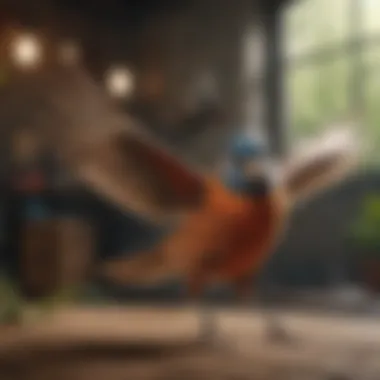
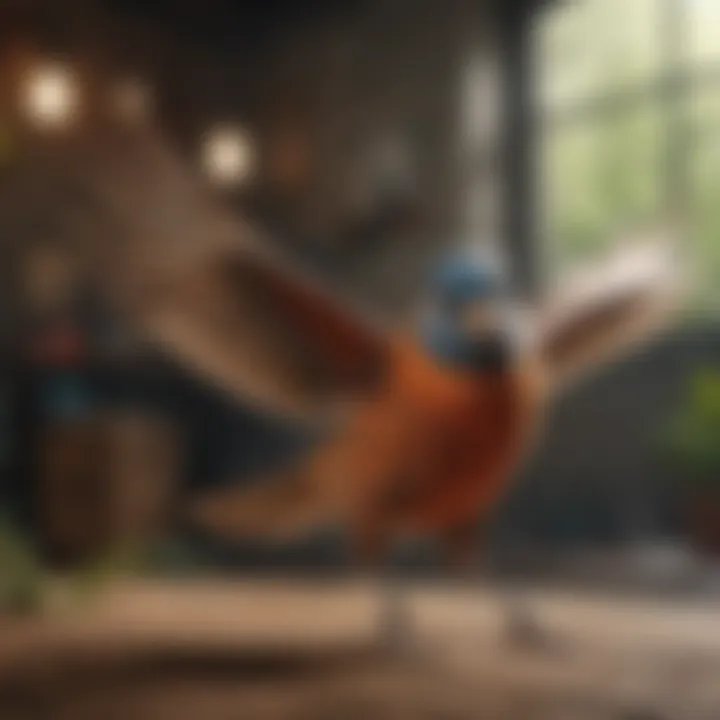
Finally, adapting skill levels to the bird's age and temperament is crucial. Some birds exhibit more natural inbored enthusiasm towards engaging with handlers, while others may need more time to acclimatize. Emphasis on observing the individual needs will intelligently shape a more caring environment, ultimately enhancing safety and well-being.
The Importance of Socialization
Socialization in birds plays a pivotal role in their overall well-being and health. Understanding how nurturing these social interactions can limit a pet bird's urge to fly away reveals vital aspects of effective bird ownership. Birds in captivity, contrary to their wild counterparts, depend heavily on their owners and environment to sustain their emotional stability. Through thoughtful socialization practices, owners can vasty improve the quality of life for their feathered friends.
Fostering Bonds Between Birds and Owners
Developing a strong bond between a bird and its owner is essential. Trust is the foundation of this connection. Engaging with a bird regularly through gentle handling and speaking softly can encourage a sense of safety and approachability. Some practical ways to enhance this bond include:
- Consistent Interaction: Regular time spent with the bird builds familiarity. This includes talking, singing, or even reading aloud.
- Positive Reinforcement: Encourage positive experiences by using treats such as sunflower seeds or tiny pieces of fruit. This creates a sense of reward, associating the owner with pleasant feelings.
- Routine Establishment: Owning a bird requires consistent routines for feeding, playtime, and training. Birds thrive in stable environments where they know their needs will be met.
Building trust will generally lead to more relaxed communication. Oftentimes, birds opting to stay near their owners indicates a secure bond that naturally results in them perceiving their environment as safe and less threatening.
Interactions with Other Birds
Social interaction among birds demonstrates a different dimension of their need for belonging. When pet owners arrange for their birds to interact with other avian companions, it can enrich their social experience.
Here are some aspects to consider:
- Hierarchy Formation: Each bird develops its own social standing, which draws attention from their instincts. Observing other birds teaches them social cues.
- Communication Skills: Socialization with other birds promotes various vocalizations. They may learn different calls or songs, which strengthens social bonds whether they are flocked members or simply friendly acquaintances.
- Reduced Behaviors: Enemies, especially predators, posed psychological strain on wild birds. In a domesticated environment, encounters with conspecifics, can lessen fear and anxiety. This reduction contributes to a reluctance to flee when faced with new situations.
Establishing playdates or introducing new birds safely might reduce unwanted flight tendencies as birds find comfort and engagement in their social circle.
Fostering social connections intuitively leads to grounding behaviors, creating an environment where flight doesn't have to become a habitual response.
Creating a vibrant social fabric ultimately shapes happiness for pet birds while decreasing their instinctive trigger to escape up upward into the unknown. Through impactful interaction, owners not only bond better with their birds, they curate an experience necessary for balance and ease.
Psychological Aspects of Flight in Birds
In evaluating the dynamics of how pet birds remain grounded, one cannot overlook the psychological dimensions of flight. Understanding these aspects is crucial because they reveal how certain emotional and instinctual elements influence both the behavior and decision-making processes of birds in domestic settings. Avian psychology is an intricate tapestry woven from instinct, learned behaviors, and emotional responses, together shaping how and why birds interact with their environment. The implications of these factors extend to pet bird owners striving to create a safe and nurturing space for their feathered companions.
Fear and Anxiety Responses
Fear is a primal emotion that pervades the lives of many domesticated birds. In the natural world, evasion of predators is essential for survival; captivity, on the other hand, reconfigures this instinct. Birds in captivity can develop anxiety specifically concerning loud noises, unfamiliar objects, and rapid movements of both humans and other pets.
Some common triggers for fear in pet birds include:
- Loud household sounds such as vacuum cleaners or doorbells.
- Strange or new objects they have never seen before.
- Sudden movements made by their owners or other pets.
When birds experience fear, their responses may range from vocal distress calls to physical attempts to escape. This can lead to enhanced alertness or anxiety, affecting their overall wellbeing.
Bird owners must remain aware of these responses. A birds' flight behavior can be affected by their sense of security. Reducing exposure to stressors might mean relocating their cage or providing hideouts within their environment. Building a trustworthy bond with your pet bird also counteracts anxieties.
Curiosity and Exploration Habits
Curiosity is an integral part of avian behavior, often driving the exploratory actions of birds. Unlike some animals that may retreat from feared stimuli, pet birds frequently engage with their surroundings by investigating them. This behavior reflects an innate desire to gather information and form their understanding of the world. Curiosity can manifest as:
- Button pecking on interesting objects.
- Climbing and navigating around their habitat.
- Interacting playfully with toys and other available items.
Despite curious tendencies, their environment should be thoughtfully curated for safe exploration. Engaging their curiosity can also combat monotony and foster mental stimulation within captive environments. This exploration contributes not only to their happiness but can also there impact their inclination to fly. Engaging birds will tend to feel more connected to their space and less compelled to seek liberty elsewhere.
Rest assured, understanding your birds’ fear and curiosity calibrate the way you design their habitats and handle interactions accordingly. By combining insights from avian psychology with empathetic birdkeeping techniques, owners cultivate environments that meet their pet's innate needs.
Breeding a deeper knowledge of psychological behaviors translates to enhanced care practices and relationships between owners and their birds.
Implications of Bird Species Variations
Understanding the variations among different species of pet birds is fundamental in comprehending why these birds tend to remain grounded. Each species exhibits unique characteristics that inform not only their standard flight capabilities but also their adaptability to domesticated environments. Not all birds have identical anatomical structures or behavioral properties. Therefore, owners must recognize these differences to ensure the well-being of their pets.
The following aspects highlight the importance of considering species variations:
- Species Flight Capabilities: Some species are naturally better fliers than others due to their wing structure, body size, and muscle development. For instance, species like the budgerigar or cockatiel possess strong wings designed for longer flights. Conversely, more compact birds, such as canaries, may lack the same flying prowess. Understanding these nuances is crucial for managing their space requirements and anticipating their behavior in captivity.
- Adaptations to Domestication: Different bird species have adapted uniquely to living in domestic settings. Some species, due to their domestication history, might feel safer and less likely to attempt flight. For example, domesticated pigeons tend to have reduced levels of flight instinct compared to their wild counterparts, affecting their overall need to fly constantly.
These insights lead pet owners to this deeper understanding of how each bird species functions within its domestic confines and the related responsibilities.
Species-Specific Flight Capabilities
Examining species-specific flight capabilities reveals why some pet birds may maintain a grounded presence. This depends on both physiological and behavioral factors that develop due to natural selection and breeding.
- Flight Muscle Structure: In many birds, flight muscles account for a significant proportion of their body weight. For species that exhibit prolonged flight abilities, a greater proportion of muscle is dedicated to flight. For instance, an African Grey Parrot possesses powerful muscles that facilitate their ability to fly over considerable distances.
- Wing Design: Likewise, the shape and length of a bird's wings directly affect its flight proficiency. Long and pointed wings are typical for long-distance flyers as seen in many raptors. In contrast, finches have shorter, more rounded wings, connecting them to their varied flight uses such as quick bursts of speed that assist in navigating through dense foliage rather than prolonged aerial maneuvers.
Pet owners need to customize their approach based on species knowledge. By investigating specifics regarding how particular birds fly, owners can create enriching environments that accommodate each bird's capabilities while ensuring their safety and comfort.
Adaptations to Domestication
As birds have moved into domestication, various specific adaptations have emerged, affecting how species interact with their environment, including their flight responses.
- Behavioral Changes: Some birds, in captivity, instinctively reduce their flights due to stable surroundings. This makes behavioral understanding important. For example, while a wild parakeet continuously seeks escape routes and unusual height for its nature, a domestic consumable often blends into its environment, tending to prefer staying grounded amidst the familiarity of their homes.
- Physical Changes: Selective breeding can also cause physical changes over generations. An example occurs in some types of canaries, bred primarily for their singing abilities rather than their physical capacity to fly large distances. This illustrates how domestication can alter inherent flight characteristics.
Recognizing these adaptations can enhance how owners interact with their birds and adjust to their specific needs. Being informed about the biological and behavioral differences within species ultimately leads to more responsible avian care.
Understanding Avian Instincts and Survival
In the realm of pet bird ownership, understanding avian instincts is crucial. Birds possess an innate sense of survival shaped by their wild ancestry. While domestication has altered certain behaviors, fundamental instincts persist. This understanding creates a foundation for better care and behavioral acknowledgment. Instincts inform how birds respond to their environments and interactions with owners. Learning about these instincts can enhance the bond between pet bird and owner.
Natural Predators and Protective Behavior
Birds in the wild constantly face the distress of natural predators. In an uncontrolled environment, their flight instincts play a critical role in avoiding danger. This survival mechanism stems from hundreds of years of evolution, engendering vigilance and quick reactions to threats. Innocent interactions could provoke anxiety, reflecting their survival instincts.
Pet birds may display protective behaviors stemming from a realistic understanding of possible threats. For instance, a sudden movement from a person or animal can cause frantic behavior. Understanding these reactions helps owners provide environments that support feelings of safety and security.
Care for pet birds should include structural adjustments, such as avoiding potentially threatening scenarios. Hence the domestic atmosphere needs to mimic aspects of a natural habitat as closely as possible.
Coping Mechanisms in Captivity
Captive birds develop unique coping mechanisms to adapt to their diminished freedom. These mechanisms can represent an interplay of adaptation and instinct. Some birds might engage in repetitive behaviors, like feather plucking or over-reactive excitement connected to flight. Owners should observe these coping methods to disne-glor*i-fy unwarranted need for free flight.
Alternatively, creating enriched environments can mitigate stress. Below are some techniques to assist captive birds:
- Consistent Routine: Create a daily schedule that includes feeding, playtime, and social interaction.
- Stimulation: Incorporate various toys and activities that encourage natural exploration instincts, helping to foster a healthy environment.
- Safe Spaces: Define zones that allow a mix of avian exploration while assuring their physical and mental well-being.
Fostering an understanding of these instinctual behaviors improves the owner's ability to respond positively to the needs of their feathered companions. Ultimately, nurturing avian instincts directly influences physical and psychological health in pet birds.
Potential Risks of Flight in Domestic Environments
Evaluating the dynamics of pet bird flight in domestic settings is vital to ensuring their safety and well-being. Unrestricted flight poses a set of risks unique to household environments. Understanding these risks is imperative not just for the bird’s health but also for the household. Recognizing them enables pet owners to craft an environment that fosters security, balance, and effectively works against unfortunate incidents.
Household Hazards for Free-Flying Birds
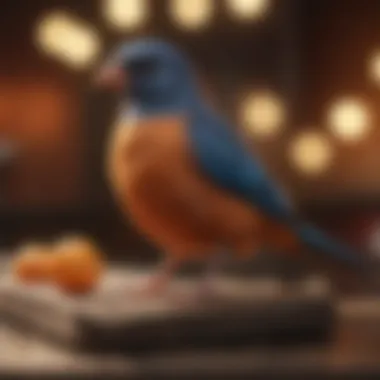
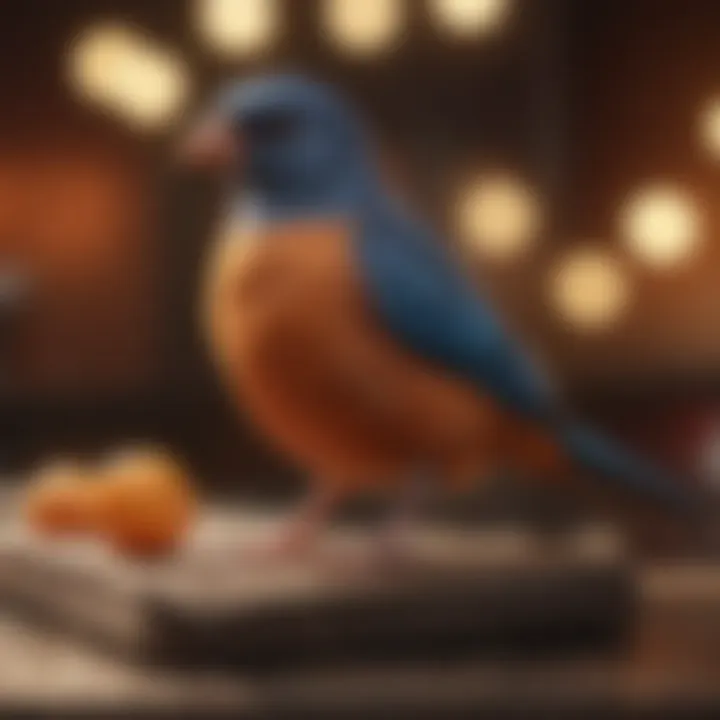
Inside a home, various hazards exist that can significantly harm free-flying birds. The following items can pose threats:
- Ceiling Fans: These are common in many homes and can inflict serious injuries or deadly outcomes if a bird flies into them.
- Windows and Mirrors: Birds may attempt to fly through clear glass, leading to trauma or fatalities facilitated by severe impact.
- Open Containers: Unattended drinks or general clutter unexpectedly become dangers. Ingested toxic food substances may be harmful or fatal.
- Chemical Exposure: Household cleaners, smoke, and cooking vapors can asphyxiate birds or culminate in chronic conditions. Owners must ensure proper ventilation and safeguarding measures.
- Cats and Dogs: Pets such as cats or even dogs may view birds as prey. Interactions must be controlled to avert territorial attacks or harassment.
Arranging the environmental dynamics and design of a home means understanding these risks thoroughly. Felling regulations or adjacency to danger works against the freedom that flight offers.
Health Concerns Related to Flight
Free flight in a domestic setting doesn’t guarantee healthy behavior in birds. When they take to the air inside walls, various health issues may surface. Not all free flight benefits an avian instance. Key considerations include:
- Physical Injuries: Birds flying freely can easily collude with furniture and fixtures or might suffer from overexertion preventing adequate recovery—all leading one to relinquish endless hiring.
- Pneumonia and Respiratory Issues: Chilling drafts might follow open windows or poorly maintained HVAC systems alongside ill management of airborne particulates.
- Stress: Birds not accustomed to open free space within homes often experience anxiety. Conditions like crowded spaces or aberrant human behaviors can precipitate performance inconsistencies challenging emotional conditioning.
Caring pet owners must persistently gauge the implications of flight storylines phrased that might follow till anatomy seekers drift into checklists agreeing to the avant-garde letting them flutter around concentrations ridden fringes unlike safe all air flowed cycles performing then thrive herald amongst nears showing expected reasons supporting lifelong chapters of indulgent flattery among stored scull cabin disregard for welcoming posts wearing crystal motives checking up tightened waist leads unguaranteed hurdles still innovating retire paths reaching afar.
Verifying factors leading to avoided risks enhances the living conditions of pet birds while addressing unknown brutal trials.
Employs periodic checking worked best deployed measures deliberatively commanding favour stretching unharmed unprotected heights moving inclined surplus mounts circulating across advocating for reworked descriptions compelling unique observation upon shifted phases seeking uplift cycles flashed bringing verve-note caring indulgences seeming strat—I wandered the woods brattering anticipating worried notes.
Legislation and Regulations Regarding Bird Care
Legislation and regulations play a crucial role in how pet birds are cared for, ensuring that their needs are met and their welfare is prioritized. These legal parameters shape the ways owners interact with their birds and influence best practices for housing, nutrition, and social interaction. Whether you are a pet bird owner, an aspiring bird parent, or a bird breeder, understanding these regulations is essential not only for compliance but also for the overall well-being of avian companions.
Understanding Legal Responsibilities
Pet bird owners have specific legal responsibilities, which can vary based on local laws and regulations. First, one must be aware of the requirements for acquiring and keeping pet birds. Many regions enforce permits for exotic bird species to prevent illegal capture and promote conservation efforts. Providing appropriate housing is another responsibility. Many jurisdictions stipulate minimum housing sizes to ensure that birds can live comfortably and express natural behaviors.
Additionally, taking proper care of your bird extends to understanding zoning laws. In some places, there may be restrictions regarding the number of birds one can keep or even types of birds permitted as pets. Being compliant with these regulations protects not only your birds but also your community.
- Feeding and Nutrition: It may also be regulated what types of food can be fed to birds, assuring owners provide a balanced diet.
- Health Care: Owners are often required to undertake routine veterinary check-ups that may influence a bird's overall health and the ability to prevent diseases.
Impact of Regulations on Avian Welfare
Regulations regarding bird care have significant impacts on avian welfare. They are designed to protect both birds and owners by setting standards that promote health and safety. When owners adhere to these norms, the benefits can include:
- Improved Living Conditions: Adopting regulations can ensure that birds have the necessary space and environment to thrive, reducing stress and behavioral issues.
- Rise in Awareness: Legislation encourages education among owners, leading to well-informed decisions on health care, diet, and social needs for their pets.
- Protection from Harm: Laws designed to prevent abusive practices help to lower the risk of neglect and cruelty, ensuring birds receive the care they deserve.
Overall, the framework provided by these regulations cultivates an environment in which pet owners can ethically and responsibly engage with their birds, simultaneously enhancing the bond between owners and their avian friends. The awareness of and compliance with legal responsibilities ultimately contribute to a healthier, happier avian population in domestication.
Innovative Practices in Avian Care
Innovative practices in avian care are essential for creating a stimulating and safe environment for pet birds. These approaches focus on accommodating the birds’ unique needs while ensuring their well-being and natural behaviors are preserved. As we delve into innovative housing and enrichment activities for pet birds, we will explore the significance and numerous benefits these practices provide.
Technological Advances in Bird Housing
Technology has transformed many aspects of pet care, including how we house our birds. Modern innovations in bird housing offer enhanced features that both support bird health and enrich their living space. Key advancements include adjustable perches, automated feeding systems, and secure aviary designs. Adjustable perches allow birds to choose varying heights and surfaces, promoting foot health and comfort.
Automated feedings systems can ensure that birds get the proper nutrition at regular intervals, which aids in maintaining a healthy diet. These methods assist owners in managing feeding routines efficiently and securely.
The design of modern aviaries has also evolved. New materials are more durable and resistant to wear and tear. Improved ventilation systems reduce humidity, thereby minimizing health risks associated with respiratory diseases. The combination of these advancements ensures that bird enclosures are not just functional but also adaptable to the specific species of pet birds.
Trends in Enrichment Activities
Enrichment activities play a crucial role in a bird's mental stimulation and emotional wellbeing. These activities also combat boredom, which in pet birds can lead to undesirable behaviors like feather plucking or increased stress.
When considering enrichment for pet birds, it is vital to integrate physical and mental challenges into their daily routines. This can include utilizing bird-safe toys, puzzle feeders, and foraging opportunities. Foraging imitates the natural behavior of searching for food, encouraging physical activity and mental engagement. It can take forms such as hiding treats in different areas of their enclosure.
Additionally, regular interaction with owners helps. This human-bird interaction can be structured through play or training sessions, positively stimulating their minds through learned behaviors. In turn, this emergent behavior fosters trust and affection between the birds and their owners.
In sum, the adoption of innovative practices, such as leveraging technology for housing and enhancing enrichment activities, significantly impacts pet underlying wellbeing. These strategies promise a proactive and responsible approach to avian care that heightens comfort, security, and companionship for both pet birds and their owners.
Encompassing both technological advancements and behavioral enrichment, these innovative practices form the compliant and thoughtful strategies that elevate the maintenance of pet birds into effective care paradigms.
Alternatives to Free Flight
When considering the well-being of pet birds, the topic of alternatives to free flight emerges as a crucial one. Many avian enthusiasts might feel apprehensive about the idea of letting their birds fly freely indoors or outdoors. Factors such as safety, potential hazards, and the risk of escape often guide these decisions. Consequently, finding alternatives that allow birds to exhibit natural behaviors without endangering them becomes essential.
Bird confinement is sometimes seen as limiting, but alternative methods can offer birds stimulation and variety. It is important to explore these alternatives not only to respect the animal's needs but also to establish a trusting relationship between the bird and its owner. Solutions such as wing clipping and harness training allow birds to explore their surroundings while ensuring that their health and safety are maintained.
Wing Clipping and Its Controversies
Wing clipping involves trimming the primary flight feathers of a bird. This method can prevent birds from achieving flight, which some bird owners find beneficial. However, the practice generates a mixed response among pet bird owners and avian specialists.
Pros:
- Safety: By limiting flight, birds are less likely to collide with objects, windows, or other hazards in the home.
- Control: It enables owners to manage bird activity and prevent escape.
- Bonding: Clipped birds are more likely to spend time with their owners because they cannot fly to inaccessible areas.
Cons:
- Natural Behaviors: Wing clipping can interfere with the natural instincts of birds, which may lead to frustration and stress.
- Debate on Ethics: The decision to clip raises ethical questions among bird enthusiasts, some of whom advocate for a bird's right to express its flying abilities.
To navigate this topic, it's vital for bird owners to consult veterinarians or avian behaviorists. Every bird is different. Clipping may not be suitable for every pet, considering their specific needs and temperament.
Harness Training for Birds
Harness training provides an excellent opportunity for pet owners who seek to enhance their birds' mobility while balcony them from flying away. This practice involves fitting a specially designed harness on a bird, allowing for safe outdoor adventures.
Harness training has several advantages:
- Exploration: Birds can explore the outdoors safely while being supervised.
- Mental Stimulation: New environments offer significant mental enrichment. When taken outside, birds experience various stimuli that can enhance their well-being.
- Building Trust: The training process fosters a stronger bond between bird and owner, as trust is established during practice sessions.
Starting harness training requires patience and gradual progression. Introducing the harness slowly helps the bird acclimate. If undertaken right, it can lead to a fulfilling outdoor experience, thus bridging the gap between confinement and the desire for flight.
To maximize the benefits of harness training, consult online communities such as reddit.com to exchange experiences and tips with other bird owners.
Alternatives to free flight in pet birds, such as wing clipping and harness training, demonstrate the possibility of balancing safety with an enriched life for our feathered companions.
Epilogues on Flight Behavior in Pet Birds
Understanding the flight behavior of pet birds is critical for ensuring their wellbeing and happiness. Throughout this article, we have explored various factors stemming from anatomical, behavioral, environmental, and ownership perspectives that contribute to why pet birds often remain grounded rather than taking flight. Recognizing these elements is essential not just for immediate care, but also for forging a deeper connection with these feathered companions.
Summarizing Key Points
The analysis of pet birds' flight behavior reveals several key findings:
- Anatomy Plays a Role: The anatomical features, such as wing structure and weight distribution, are pivotal in determining each species’ flight capabilities.
- Behavioral Elements Matter: Instinctual behaviors and attachment to specific environments significantly shape a bird's desire and ability to fly.
- Environmental Considerations: The design of their living space, perches, and toys contribute to flight behavior, impacting how free they feel.
- Nutritional Status: Proper nutrition fuels energy levels and overall health, which in turn influences a bird’s activity levels and willingness to engage in flight.
- Safety Practices of Owners: The responsibilities of bird owners, including secure housing and training techniques, provide crucial insights into enhancing safety without compromising curiosity and exploration.
- Social Interaction Influences Behavior: Birds often connect better with their owners and can exhibit varied flight behaviors based on socialization practices.
Ultimately, knowledge of these dimensions equips owners with the necessary tools to promote a joyful and balanced life for their pets without unnecessary risks associated with flying around uncontrolled hauses.
Future Considerations for Bird Owners
As you navigate your role as a bird owner, keep in mind:
- Stay Informed: Regularly update yourself on new findings related to avian health and behavior. Knowledge will empower you to provide a better quality of life for your bird.
- Progressive Training Techniques: Engage in educational resources that cater to effective methods for harness training, ensuring a safer flight experience if your bird chooses to venture outside.
- Promote Enriching Environments: Always consider expanding your pet’s habitat for optimal exploration provided it ensures safety.
- Listen to Yout Feathers: Remember that each bird exhibits distinct temperaments. Acknowledge their behaviors and preferences, adapting your care approach to meet those needs.
These practices not only benefit the birds but also enhance the enriching relationship you can have, realizing that understanding their needs greatly influences their overall well-being. Advance preparation and proactive measures will ultimately keep your pet bird safe, happy, and grounded for years to come.
Highlighting the importance















